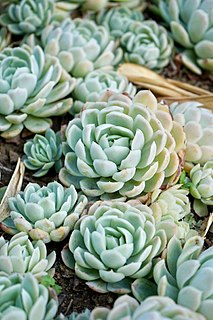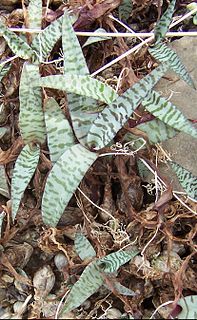
Echeveria is a large genus of flowering plants in the family Crassulaceae, native to semi-desert areas of Central America, Mexico and northwestern South America.

Zamia is a genus of cycad of the family Zamiaceae, native to Mexico, the West Indies, and Central and South America as far south as Bolivia. The range of one species (Z. integrifolia, extends into the contiguous United States, i.e. Georgia and Florida.

Argythamnia is a genus of plants of the family Euphorbiaceae first described as a genus in 1756. They are known commonly as silverbushes.

Westringia is a genus of Australian shrubs. As with other members of the mint family their upper petal is divided into two lobes. There are four stamens - the upper two are fertile while the lower two are reduced to staminodes. The leaves are in whorls of 3 or 4.

Ledebouria is a genus of African bulbous perennial herbs in the Asparagus family, Asparagaceae, subfamily Scilloideae. Most members were previously part of the genus Scilla. A number of species are grown by cacti and succulent enthusiasts for their patterned leaves.

Bulbine is a genus of plants in the family Asphodelaceae and subfamily Asphodeloideae, named for the bulb-shaped tuber of many species. It was formerly placed in the Liliaceae. It is found chiefly in Southern Africa, with a few species extending into tropical Africa and a few others in Australia and Yemen.
Zamia cremnophila is a species of plant in the family Zamiaceae. It is endemic to the state of Tabasco in Mexico, between Teapa and Tapijulapa.

In botany, succulent plants, also known as succulents, are plants with parts that are thickened, fleshy, and engorged, usually to retain water in arid climates or soil conditions. It is a characteristic that is not used scientifically for the definition of most families and genera of plants because it often can be used as an accurate characteristic only at the single species level. The word succulent comes from the Latin word sucus, meaning 'juice', or 'sap'. Succulent plants may store water in various structures, such as leaves and stems. The water content of some succulent organs can get up to 90-95%. Some definitions also include roots, thus geophytes that survive unfavorable periods by dying back to underground storage organs may be regarded as succulents. In horticultural use, the term succulent is sometimes used in a way that excludes plants that botanists would regard as succulents, such as cacti. Succulents are often grown as ornamental plants because of their striking and unusual appearance, as well as their ability to thrive with relatively minimal care.

× Cremnosedum is a hybrid genus produced from crosses involving the genera Cremnophila and Sedum. This bigeneric name was first published in 1981 with the introduction of the cultivar 'Little Gem' in an article advertising plants offered by the International Succulent Institute in the Cactus and Succulent Journal, the journal of the Cactus and Succulent Society of America. The 'Little Gem' cultivar was made by Mrs. and Mr. Robert Grim of San Jose, California and is described as producing a low mat of small rosettes. It prefers direct sunlight and produces small yellow flowers on short stalks.
Cremnophila pyraustella is a species of snout moth in the genus Cremnophila. It was described by Zerny in 1914, and is known from China.
Cremnophila sedakovella is a species of snout moth in the genus Cremnophila. It was described by Eduard Friedrich Eversmann in 1851 and is known from Russia, Austria, Switzerland, Italy and Spain.
Westringia cremnophila, commonly known as Snowy River westringia, is a rare shrub that is endemic to Victoria, Australia.

Oscularia is a genus of succulent flowering plants in the family Aizoaceae, native to semi-arid and rocky habitats in the Western Cape of South Africa.

Astroloba is a genus of flowering plants in the family Asphodelaceae, subfamily Asphodeloideae, native to the Cape Province of South Africa.

Buffelspoort, is a deep gorge and river valley situated in the Western Cape province of South Africa.
Boronia cremnophila, commonly known as the Kimberley cliff boronia, is a plant in the citrus family, Rutaceae and is endemic to a small area in the Kimberley region of Western Australia. It is an erect or spreading shrub with both simple, and trifoliate leaves, and white sepals and petals, the sepals larger than the petals.
Ivania is a genus of flowering plants belonging to the family Brassicaceae.
Cremnophila may refer to:
Cremnophila is a genus of flowering plants belonging to the family Crassulaceae.










